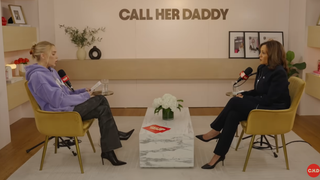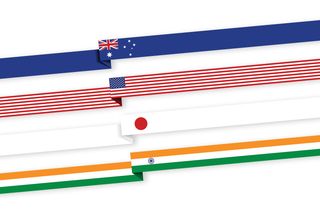Just a few years ago, a US presidential candidate’s campaign schedule was relatively predictable. A whistle-stop tour of rallies across battleground states, a handful of prime-time interviews, and wall-to-wall advertisements in broadcast media. But in 2024, a new stop has been added to the media circuit: podcast studios.
In the leadup to election day, Kamala Harris, Tim Walz, Donald Trump and J.D. Vance have all sat down with some of America’s leading podcast hosts and YouTubers – an eclectic mix of influencers, sports players, comedians, legacy media outlets and online personalities – in a bid to secure victory on November 5.
As journalist Seema Mehta noted in the LA Times, this focus on non-traditional outlets is the latest iteration of “microtargeting” – or efforts by political campaigns to zero in on specific blocs of voters rather than addressing the masses. Harris and Trump are seeking to cut through in an increasingly fragmented and saturated media market as voter registration deadlines rapidly approach and election day nears.
According to Edison Research, 47 per cent of Americans now listen to podcasts every month. For both candidates, this format represents an opportunity to leverage the parasocial relationships between a podcast host and their audience, while also connecting with potential voters in a space perhaps more comfortable for them than traditional media.
Earlier this month, Kamala Harris sat down with Alex Cooper on the wildly successful Call Her Daddy podcast, which Spotify reports to be second-most-listened-to podcast in the world behind The Joe Rogan Experience.
While the podcast is perhaps best known for its frank discussions on sex and its celebrity interviews, its audience is predominantly young (76 per cent of listeners are aged under 35) and female – both key voting blocs Harris needs to win. What’s more, 20 per cent of listeners say they are independent voters, giving Harris opportunity to reach the ears of Americans who may be yet to make up their mind this election.
Cooper opened their 45-minute conversation by telling Harris she wanted “to get to know you as a person,” and the pair explored the vice president’s family life, personal history and her views on women’s rights. None of the topics were particularly groundbreaking to people familiar with Harris, but did help her reach a new audience.
Harris also spent time with radio host Charlamagne Tha God, and former NBA players Matt Barnes and Stephen Jackson on their podcast All the Smoke – both hugely popular among young black male voters, another voter group she is struggling to win over.
Even an interview with radio shock jock Howard Stern, which confused some given Stern’s long-standing reputation for lewd and crude interviews, makes sense in the context of his listenership, which is predominantly middle-class Americans – a voter base Harris has made the centrepiece of her campaign. This also tracks with Walz’s appearance on SmartLess, a podcast hosted by actors Jason Bateman, Will Arnett and Sean Hayes.
The Democrats’ media strategy suggests three things. First, that Harris and Walz are engaging with podcasts to speak to as many traditional Democratic constituents as possible to reassure them the party is safe. Second, to broaden their appeal and wrest away some of the so-called “bro vote” that Trump has been so successful at courting in recent election cycles. And finally, that they are keenly aware 2024 could be the year that small pockets of undecided voters across key battleground states determine the election.
This final point is perhaps why Republican vice presidential nominee Vance agreed to an almost hour-long podcast interview with The New York Times earlier this month. While Trump has been capitalising on the non-traditional media ecosystem for months by tapping into the so-called “manosphere” of alt-right online spaces with podcasters and YouTubers such as comedian Theo Von, influencer Logan Paul, streamer Adin Ross (who bizarrely gifted Trump a Rolex mid-interview) and the Nelk Boys, Vance’s choice was clearly aimed at reaching a very different group.
While Trump’s choices overwhelmingly reach a younger male audience, a cohort among which he already enjoys large polling margins, young men are low-propensity voters who historically lag when it comes to turning out on election day compared with their female counterparts.
By contrast, the 20 million monthly listeners Vance reached are about as far from alt-right as you can get, with the majority of The New York Times’ audience identifying as left-leaning or politically centrist.
Unlike Harris, Trump’s podcast appearances seem to speak to voters who are already a fan of his, but are more likely to be politically disengaged. But similarly to her, Trump has been willing to discuss his personal life, talking to Von about his late brother’s battles with alcoholism – an uncharacteristically vulnerable moment from the former president in an interview that has amassed over 14 million views.
As for his strategy, Trump recently told Fox News he’s being guided not by his dozens of staffers, but by his 18-year-old son, Barron. “He tells me about all the ‘hot’ guys, people I’ve never heard of. [He says] ‘Dad, that guy is hot.’”
In contrast to Harris, all signs indicate that Trump is leaning into his 2020 election strategy: doubling down on appealing to his existing base.
But Democrats are seemingly willing to go there too, with reports Harris may appear on The Joe Rogan Experience podcast (where the audience skews young, male and distrustful of traditional media sources).
Perhaps one of the biggest drawcards to this burgeoning format for candidates, though, is that the hosts rarely give them the kind of grilling they usually receive from traditional media. This is unsurprising given most aren’t trained journalists, but it does run the risk of leaving voters with more questions than answers. Or worse, uninspired on election day.









